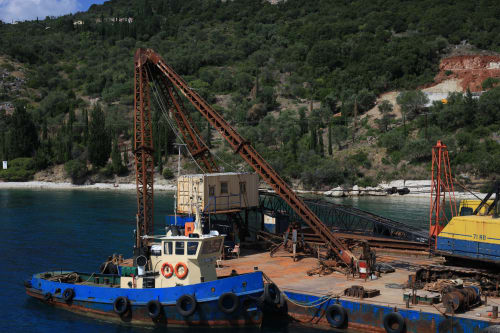Kevin Kavanagh is pleased to present Blume, an exhibition of new paintings by Paul McKinley.
Though very much a studio artist, Paul McKinley finds his source material outside the studio, and indeed outside of painting itself. His methods don’t change so much as they’re applied to different subjects and concerns, primarily a fascination with other lives and the traces they leave upon the physical world. Typically working from found photographs and other, second-hand encounters, for this new body of paintings and drawings McKinley visited the Greek Island of Ithaca. He made his own record, his personal experience colouring his response to the island’s mythical heritage. The artist has previously explored contrasts between the historical legacy of Greece and its contemporary condition, particularly as a destination for migrations from Asia and the Middle East. The works in Blume also focus on a difficult journey. At the heart of Homer’s Odyssey, the determination of Odysseus to return to Ithaca has become a paradigm for the magnetic draw of home. Encouraged to remain there for the sake of ourselves and others, in the current pandemic the cosy affinities of home have become more nuanced, while the mass migrations of recent years remind us that home is not always a desirable or welcoming place. The place McKinley repeatedly comes home to is the canvas support itself. The literal site of his painting practice, and the tabula rasa upon which his real and imaginary locations are grounded.
An incremental covering that feels almost organic (like lichen growing, perhaps), the artist’s distinctive manner of painting is a device for examining different subjects through a consistent method of enquiry. This method, painstaking, deliberate and extremely slow, is also a form of meditation, the suspension of thought for another kind of thinking. Underlying truths can come to the surface that way, especially if we don’t look for them too hard. Painting’s relationship to truth is of course complicated, not least in how a representational painting (in particular) mimics appearances while simultaneously being an appearance of itself. This dichotomy, between the physical reality of a painting and what it’s deemed to represent, is heightened in McKinley’s work in a number of interesting ways. His paintings can look conventional at first sight, their subject matter merely pretty or innocuous. But McKinley’s subjects are never innocent. They refer in complex ways to myth, history and our embodied presence in the world.
The botanical detail in ‘Scylla’, for example, effectively conveys a thistle’s bristling threat while also standing in for the six headed monster who devours Odysseus’s crew. The natural world is seldom as natural as we think it is, and the artist plays on this disparity. The so-called natural world is also represented by animals. Transformed by Circe’s magic potions, drawings of a lion and a wolf stare straight at us, as though communing with their human counterparts through the eyes of the beasts they’ve been turned into. We never see the human figure directly in McKinley’s work, but by reflection in the stories and landscapes they inhabit.
The surface of his paintings can appear homogenous, not ‘painterly’ in the usual sense, but as though the paint was applied by an unwavering machine. This is also misleading. The apparently uniform surface of a painting like ‘Hades’, accentuated by its singular colour (a precise combination of cadmium red and Italian burnt sienna) disguises a complex application of immensely subtle mark-marking. Depicting a simple geographical detail or the mouth of hell, it’s a place we might easily fall into. The fine detail of the artist’s renderings can also appeal to faith; something viewed this closely must be true. But the artist invents all the time. The photographs informing his work are subject to all manner of coaxing and manipulation. The painting ,‘Agios Athanasios’ was half finished when I visited his studio in early October. Still attached to the canvas, seeing the tiny, low quality snapshot against the large, detailed painting in progress revealed just how much invention the artist employs in translation.
First impressions of McKinley’s paintings are invariably false, and the artist’s ability to set-up and subsequently undo these false impressions is at the heart of their effectiveness. Outwardly beautiful, his seemingly conventional surfaces are also a kind of veneer, concealing something richer and more mysterious within. You might say the surface of the paintings are a kind of Trojan Horse, an analogy that seems particularly apt in this instance. Talking about his visit to Ithaca, the artist recalled swimming in the waters around its coastline. “I swam in his sea”, he told me, a reference to Odysseus, and testimony to the embodied nature of his research. This act of immersion is extended in Blume, as artist and viewer come together in the space of the exhibition, backdropped by a wall-sized representation of the island’s craggy coastline. Rhyming with the name of James Joyce’s Homeric hero, the exhibition title is also a reference to a poem by Paul Celan, and a cautious optimism in these cryptic lines –
“We were
hands,
we scooped the darkness empty, we found
the word that ascended summer:
Flower.”
John Graham November 2020
From Paul Celan’s Blume (Flower), first published in the collection Sprachgitter (Speech-Grille), 1959. Translated from the German by John Felstiner, 2001


